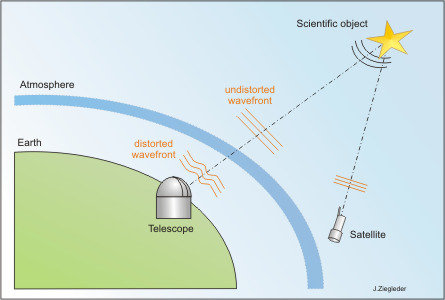Ground Layer Adaptive Optics - a Simple Introduction
Adaptive Optics in General
Why does a telescope, like the Large Binocular Telescope, need an adaptive optics system?

The resolution of large ground-based telescopes is limited by atmospheric turbulences. Placing the telescope on a satellite would avoid this, but space telescopes are limited in size and expensive.
The atmospheric turbulences can be corrected in real time by an adaptive optics system. Therefore, the wavefront of a bright star is analyzed and corrected by a deformable mirror (inspired by Claire Max, CfAO).
Hence, the resolution of a telescope is no longer limited by the atmosphere. This example shows the Galactic Center.
The adaptive optics system needs a bright light source to work. If there is no suitable object near the scientific object, a well-defined, artificial star is generated by a laser. The picture shows PARSEC, the natrium guide star of ESO's VLT-UT4.
Ground Layer Adaptive Optics
A CN2 profile shows the amount of air turbulences over height from ground. It is obvious that the strongest turbulences are close to the ground. The aim of a ground layer adaptive optics system is to compensate these turbulences over a wide field of view. (figure by E. Masciadri, INAF)
As the used laser is pulsed with 10 kHz, it looks like a continuous beam. But in fact, the facility deals with single pulses.
This is how it works:
- A laser pulse is launched above the secondary mirror and focused on a point in a height of about 12 km. With the pulse propagating through the atmosphere, a small percentage of its energy is scattered by air molecules on its path (rayleigh scattering).
- As the speed of light is known, the time can be calculated when the pulse reaches a height of about 12 km. Twice this time is when the scattered light will be back at the telescope. Here it is detected by the wavefront sensor, which is focusing on the same point as the laser beam. Due to the use of a single laser pulse, we see only the scattered light from the desired height.
As the scattered light passes the ground layers on its way back, the distortion of these layers can be obtained from the wavefront.
However, as the figure shows, one star covers only a small field above the telescope.
By generating more stars, a wider field of the air above the telescope can be analyzed.
Green lasers are often used because:
- Rayleigh scattering works best for short wavelengths.
- The telescope optics are optimized for visible and infrared light.
- Visible light simplifies the alignment of the instrument.
- They are robust and cheap, and are normally used for industrial applications.